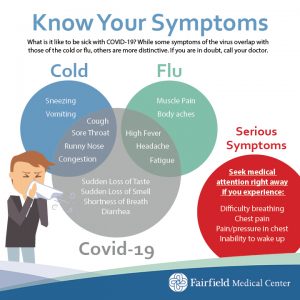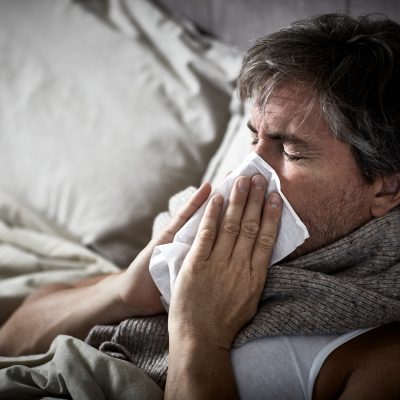Article originally published on November 30, 2020.
Article updated August 30, 2021.
Know the Difference: Cold vs. Flu vs. COVID-19
You’ve suddenly started feeling under the weather, and now you’re worried – is it COVID-19 or something else? The common cold, the flu and COVID-19 are caused by different viruses, but since they are all respiratory illnesses, the symptoms can mirror one another. While it may be difficult to tell the difference between the three, there are some distinct symptoms of each that may give you a better idea of whether you need to get tested for COVID-19.
Cold:
Colds tend to be milder than the flu and the most common symptoms are a runny or stuffy nose. You may also develop a cough or sore throat and may even become nauseous. Unlike the flu, a cold generally does not result in serious health problems, although you may develop bronchitis.
Flu:
Flu symptoms are more intense than the common cold. You will likely have a fever or chills. You may also experience muscle pain, body aches, a headache and tiredness. The flu can come on quickly, with patients developing symptoms 1-4 days after infection. If you experience symptoms of pneumonia, contact your healthcare provider.
While we saw a decrease in flu cases in 2020 secondary to COVID-19 prevention measures, influenza is still a threat to the health of our community. Learn more about flu tracking and reporting here.
Get your flu vaccine to reduce your risk of severe illness.According to the CDC, it is safe to receive both the COVID-19 vaccine and flu vaccine in the same visit, and it is no longer necessary to wait 14 days between vaccinations. Learn more about this updated guidance here.
COVID-19:
The symptoms of COVID-19 closely mirror those of the flu and a cold, with cough, sore throat, runny nose, congestion, high fever, a headache and tiredness being among the most common symptoms reported. Symptoms that are more unique to COVID-19 include sudden loss of taste or smell, shortness of breath and diarrhea. COVID-19 seems to spread more easily than the flu and causes more serious illnesses in some people. It can also take longer for people to show symptoms of COVID-19. Typically, a person develops symptoms 5 days after being infected, but they can appear as early as 2 days or as late as 14 days after infection. People with COVID-19 also can be contagious for longer.
Get your COVID-19 vaccine to reduce your risk of severe illness. Vaccination has proven effective in the prevention of serious illness, hospitalization and death. While it is possible to still become infected with COVID-19 after your vaccination, you will likely experience mild symptoms compared to those who are unvaccinated.

Testing
The best way to know if you have COVID-19 or the flu is to get tested. If you have any concerning symptoms or feel unwell, contact your healthcare provider to determine if a test is warranted. Many patients with COVID-19 experience only mild illness and can recover at home.
Some patients who are exposed to the virus may not show symptoms up until 14 days after exposure. If you have been identified as a close contact, monitor yourself closely and act accordingly. Even if you think you don’t have COVID-19 or test negative at the time of your screening, it’s important to play it safe. Stay home if you are sick.
Learn more about caring for yourself and managing symptoms at home. If you or a loved one begin experiencing the following symptoms, you need to seek medical attention right away:
- Difficulty breathing
- Chest pain
- Pain/pressure in chest
- Inability to wake up
